
2
Proprietary rights notice
Information in this document is subject to change without notice. Companies, names, and data used in examples are fictitious unless otherwise
noted. No part of this document may be reproduced or transmitted in any form or by any means, electronic, mechanical, or otherwise, for any
purpose, without the express written permission of IDEXX Laboratories. IDEXX Laboratories may have patents or pending patent applications,
trademarks, copyrights, or other intellectual or industrial property rights covering this document or subject matter in this document. The furnishing
of this document does not give a license to these property rights except as expressly provided in any written license agreement from IDEXX
Laboratories.
© 2020 IDEXX Laboratories, Inc. All rights reserved. • 06-0003888-04
*CardioPet, Cornerstone, IDEXX-PACS, IDEXX Web PACS, and VetMedStat are trademarks or registered trademarks of IDEXX Laboratories, Inc.
or its affiliates in the United States and/or other countries. Android and Google Play are trademarks of Google Inc. Apple and iPad are trademarks
of Apple Inc., registered in the U.S. and other countries. ASUS is a registered trademark of ASUSTEK Computer Corporation, Bluetooth is a
registered trademark of Bluetooth SIG Inc. DICOM is the registered trademark of the National Electrical Manufacturers Association for its
standards publications relating to digital communication of medical information. Windows is a registered trademark of Microsoft Corporation in the
United States and/or other countries.

3
Contents
CardioPet ECG Device 4
Connecting batteries and cables .................................................................................................................... 6
Preparing the patient and attaching clips ....................................................................................................... 8
Maintenance and specifications ..................................................................................................................... 9
CardioPet Software for Windows PC 10
Installing the CardioPet Software and establishing a Bluetooth connection ................................................ 12
Recording and submitting an ECG ............................................................................................................... 15
Completing the case on vetmedstat.com ..................................................................................................... 18
Working with saved ECGs ............................................................................................................................ 20
Managing patient records ............................................................................................................................. 22
CardioPet App for Android Mobile Device 23
Minimum requirements ................................................................................................................................. 25
Installing the CardioPet app and establishing a Bluetooth connection ........................................................ 26
ECG viewer settings ...................................................................................................................................... 28
Working with ECGs in the CardioPet app ..................................................................................................... 29
CardioPet iOS App 32
Minimum requirements ................................................................................................................................. 34
Checking compatibility.................................................................................................................................. 35
Configuring settings ...................................................................................................................................... 36
Installing the CardioPet app and configuring settings .................................................................................. 38
ECG viewer settings ...................................................................................................................................... 39
Working with ECGs in the CardioPet app ..................................................................................................... 40
Integrating an App with IDEXX Web PACS or IDEXX-PACS 43
Sending ECGs to IDEXX-PACS .................................................................................................................... 44
Submitting a case from within the IDEXX Web PACS or IDEXX-PACS software .......................................... 44
ECG Quality and Troubleshooting 45
Examples of diagnostic ECGs ...................................................................................................................... 47
ECG quality Indicator .................................................................................................................................... 48
Diagnostic ECG checklist ............................................................................................................................. 50
Troubleshooting ECGs ................................................................................................................................. 51
Additional troubleshooting tips ..................................................................................................................... 53
If you need help… 54
CardioPet ECG Device 4
CardioPet ECG Device
User Guide
CardioPet ECG Device 5
Contents
Connecting batteries and cables .................................................................................................................... 6
Turning the device on/off .................................................................................................................... 6
Device lights and what they mean ...................................................................................................... 7
Preparing the patient and attaching clips ....................................................................................................... 8
Maintenance and specifications ..................................................................................................................... 9
Cleaning and maintaining the CardioPet ECG Device ....................................................................... 9
Replacing and recycling batteries ...................................................................................................... 9
Specifications ..................................................................................................................................... 9

CardioPet ECG Device 6
Connecting batteries and cable
To insert batteries into the CardioPet* ECG device and connect the cables:
1. Insert two AA batteries (included) into the back of the device.
WARNING: Never use rechargeable batteries. They may cause a fire hazard. Always use
nonrechargeable alkaline batteries.
2. Attach a clip to each of the four cables.
3. Plug the single end of the cable into the CardioPet ECG Device, aligning the arrow with the white triangle
on the back of the device, as shown below.
Note: To disconnect the cable, pull the outer cylinder of the connector to release the lock.
Turning the device on/off
• To turn on the CardioPet ECG Device, press the power button .
The power light on the right side of the device will illuminate.
• To turn off the device, press the power button again.
Note: The device will turn off automatically after 5 minutes of inactivity.
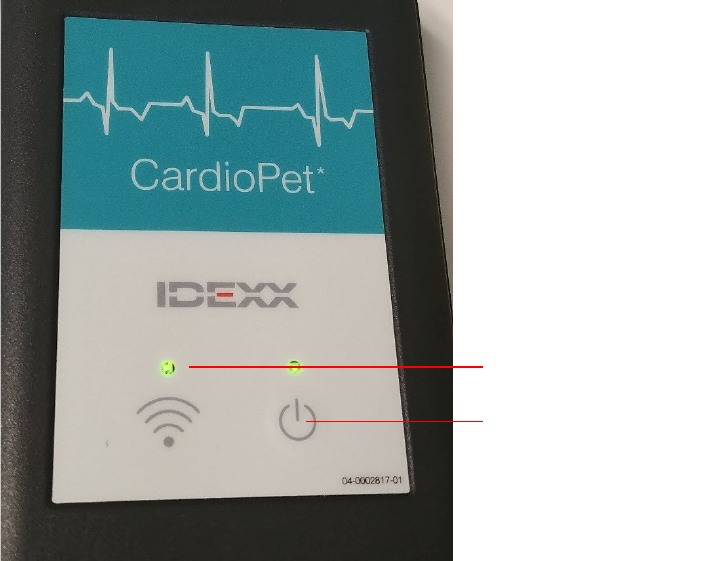
CardioPet ECG Device 7
CardioPet ECG Device lights and what they mean
The Bluetooth light to the left of the power button will illuminate when the CardioPet device is streaming to a
mobile device or computer through the CardioPet app or software.
ECG is streaming
Power button is on

CardioPet ECG Device 8
Preparing the patient and attaching clips
To prepare the patient and attach clips:
1. Place the animal on a padded surface in right-lateral recumbency.
Note: The patient can also stand upright or be in sternal position; however, be sure to note these
positions in the patient history when you submit the case.
2. Liberally apply alcohol to each limb, 1”–2” below the elbows and knees.
3. Attach the CardioPet* Comfort Clips, being sure to part the fur for good skin contact.
Black: Left front leg Red: Left rear leg
White: Right front leg Green: Right rear leg
IMPORTANT: Make sure that the patient’s limbs, the cables, and the clips do not touch each other or touch
metal. For more information, review or print this poster that explains how to prepare a patient for an ECG.
To attach clips for a chest lead ECG:
A chest lead may be helpful if the P-waves are indistinct in lead II.
1. Place all clips as described in the previous section, except the black clip.
2. Place the black clip on the left side of the chest between the fourth and fifth ribs, wherever the heartbeat
is strongest with touch or auscultation.
When you record an ECG with the clips in this position, lead I will appear as the chest lead.
3. Add “Chest lead included” in the patient history when you submit the case on vetmedstat.com.

CardioPet ECG Device 9
Maintenance and specifications
Cleaning and maintaining the CardioPet ECG Device
Clean the exterior of the device using a paper towel moistened with isopropyl alcohol.
Replacing and recycling batteries
• The CardioPet ECG Device uses two AA alkaline (nonrechargeable) batteries.
• Remove the batteries if the device will not be used for an extended period of time.
• To monitor battery status, note the battery indicator in the CardioPet software menu bar:
Battery life is adequate Battery change is needed
•
This symbol is placed in accordance with the European Union Directive 2002/96 on the Waste Electrical
and Electronic Equipment (the WEEE Directive). If disposed of within the European Union, this product
should be treated and recycled in accordance with the laws of your jurisdiction implementing the WEEE
Directive. For additional information, visit idexx.com/weee.
Specifications
CardioPet ECG Device:
• Sampling rate: 500 Hz each channel
• Signal frequency range: 0.05 Hz to 100
Hz
†
• Filter type: Digital
• Channels: 2 according to 3 or 6 vectors
• Operating range: Approximately 100 m
(clear range)
• Operating temperature: 8°C to 45°C
(46°F to 113°F)
• Ambient relative humidity: 25% to 80% without
condensation
• Atmospheric pressure: 700 hPa to 1070 hPa
†
The frequency range refers to the CardioPet ECG Device. The resulting frequency range depends on the specific filters
implemented in the software.
Batteries:
Chemistry: Alkaline (zinc-carbon dry cell)
Type: AA
Rechargeable: No
Weight: 23 g
CardioPet Software for Windows PC 10
CardioPet Software for
Windows PC
User Guide
CardioPet Software for Windows PC 11
Contents
Installing the CardioPet Software and establishing a Bluetooth connection ................................................ 12
Minimum PC requirements ............................................................................................................... 12
Installing the CardioPet software ...................................................................................................... 12
Pairing the CardioPet ECG device with the CardioPet software ...................................................... 13
Recording and submitting an ECG ............................................................................................................... 15
Quick guide to CardioPet software controls ..................................................................................... 15
Recording the ECG........................................................................................................................... 15
Adjusting the ECG display ................................................................................................................ 17
Completing the case on vetmedstat.com ..................................................................................................... 18
Completing a new case .................................................................................................................... 18
Recording and completing a repeat case ........................................................................................ 18
Working with saved ECGs ............................................................................................................................ 20
Saving an ECG as a PDF file ............................................................................................................ 20
Viewing a saved ECG ....................................................................................................................... 20
Exporting an ECG from the CardioPet software ............................................................................... 21
Importing an ECG into the CardioPet software ................................................................................ 21
Managing patient records ............................................................................................................................. 22

CardioPet Software for Windows PC 12
Installing the CardioPet software and establishing a Bluetooth
connection
IMPORTANT: This section applies only to systems that are not integrated with the IDEXX-PACS* Imaging
Software or IDEXX Web PACS*. Contact IDEXX Telemedicine Consultants at 1-800-726-1212 for additional
information about integration.
Minimum PC requirements
• Device ports: USB 1.1 or later
• Operating system: Windows* 7, Windows* 8, or Windows* 10 (32- or 64-bit)
• RAM: 2 GB
• Hard drive: 100 GB
• Internet connection
Installing the CardioPet software
1. Download and install the CardioPet* software from vetmedstat.com/cardiopet.
For assistance, contact IDEXX Telemedicine Consultants at 1-800-726-1212 or email
telemedicines[email protected]om.
Note: Some computers require administrative rights for downloading software. If you receive an error
when downloading the CardioPet software, contact your practice’s system administrator or IT person for
assistance.
2. When asked to specify your clinic ID, enter the Account Number from your IDEXX billing statements, as
shown below. The Account Number consists of numbers only.
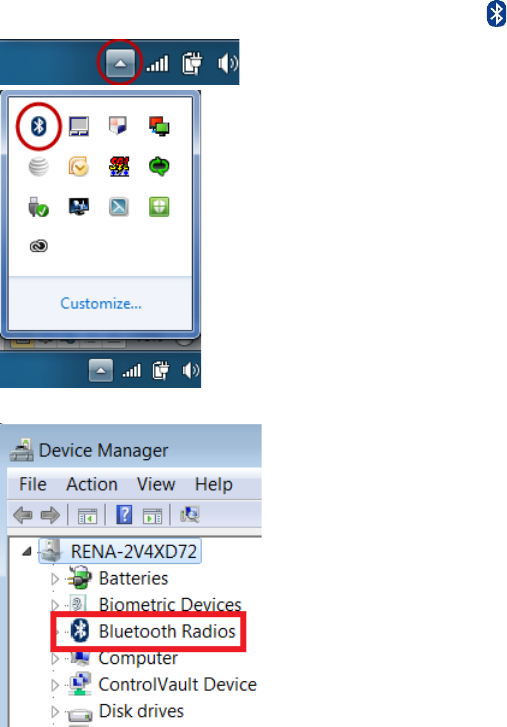
CardioPet Software for Windows PC 13
Pairing the CardioPet ECG Device with the CardioPet software
Pairing establishes wireless communication between the CardioPet* ECG Device and the software. In most
cases, you will need to pair the device only once.
Note: The device can connect to only one instance of the CardioPet software at a time. Close any other
open CardioPet applications (including the CardioPet app on a mobile device, if using).
First: Check for wireless capability on your computer:
1. In the taskbar (usually in the lower right corner of the monitor), click the up arrow to display hidden
icons, and then look for the presence of the Bluetooth* icon.
Alternatively, check your computer’s Device Manager for Bluetooth or Bluetooth Radios.
2. If the icon or radios option is not present, follow the instructions in the package you received from
IDEXX to install the Bluetooth adapter and appropriate ASUS* drivers before continuing.
IMPORTANT: If the Bluetooth adaptor is needed, it must remain connected to your computer at all
times. Removing the Bluetooth adaptor may result in your CardioPet ECG Device becoming unpaired
from the CardioPet software.
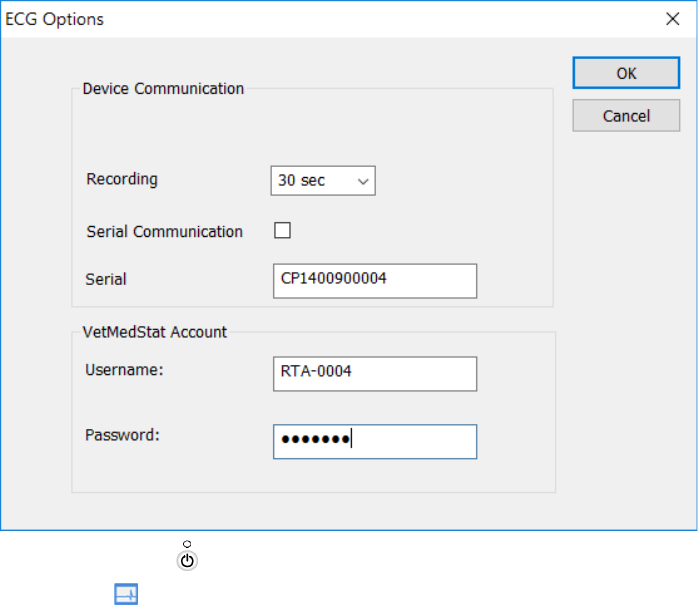
CardioPet Software for Windows PC 14
Second: Pair the CardioPet ECG Device with the CardioPet software:
1. Start the CardioPet software, and then select Settings > ECG Options….
2. Set the following ECG options:
• In the Serial Number box, enter the serial number from the label on the back of the CardioPet ECG
Device. The number starts with CP followed by nine digits (for example, CP140900014).
• In the Username box, enter your VetMedStat* account name.
Note: Your account name has 3 letters and 4 numbers (e.g., ABC-0123). If you need help,
contact us at 1-800-726-1212 or telemedicinesuppor[email protected].
• In the Password box, enter your VetMedStat* account password, and then click OK.
3. Press the Power button on the front of the CardioPet ECG Device.
4. Click Start ECG in the CardioPet software.
When pairing is successful the device begins a live ECG stream (which appears as straight or curved
lines in the CardioPet window). The CardioPet ECG Device is now ready for use with the CardioPet
software.
Note: If streaming does not begin, check your computer’s Device Manager or Bluetooth settings to
ensure:
• Bluetooth is enabled/turned on.
• Bluetooth devices are allowed to find the computer.
• Bluetooth devices are allowed to connect to the computer.
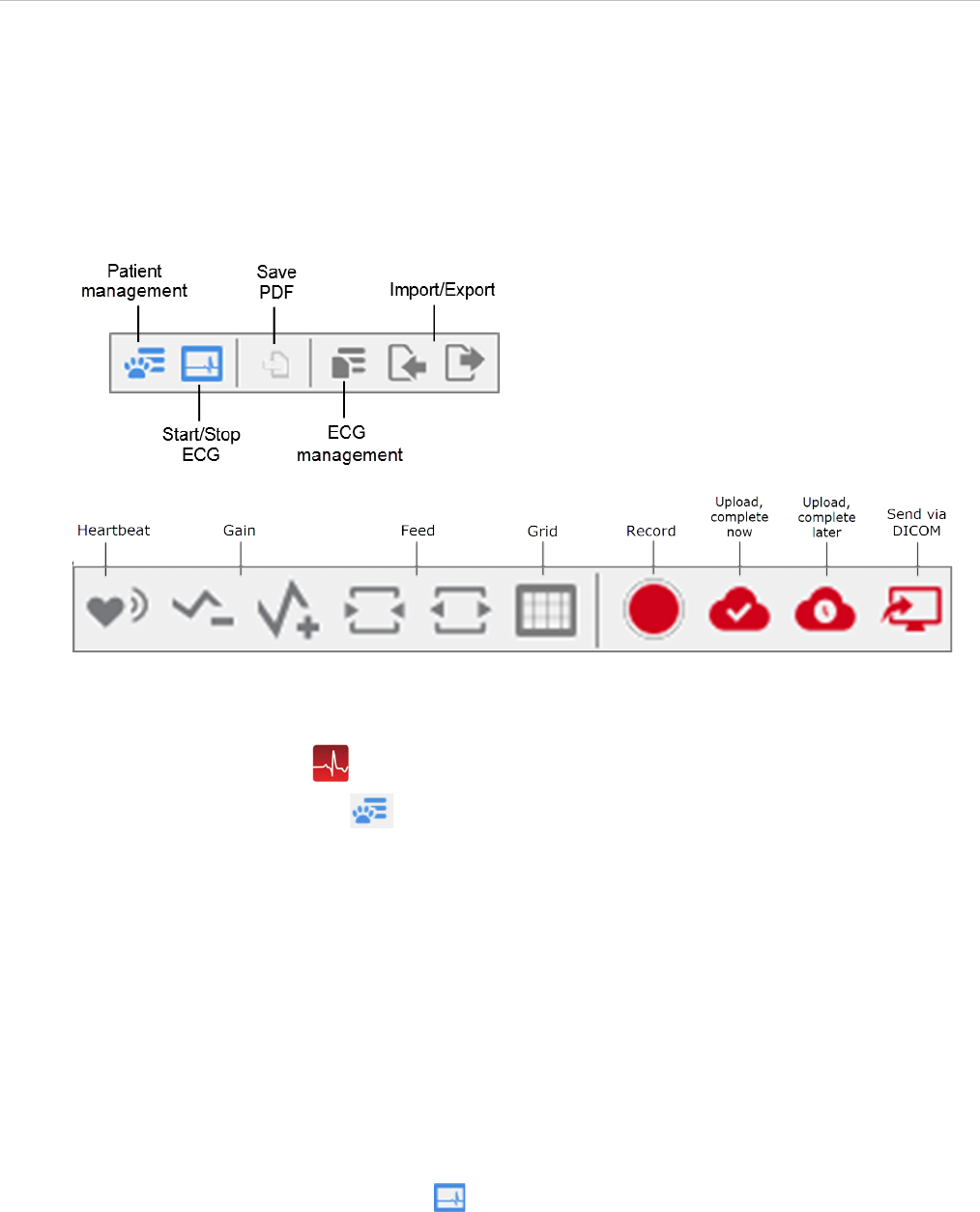
CardioPet Software for Windows PC 15
Recording and submitting an ECG
IMPORTANT: Only one instance of the CardioPet software or app can be used at a time; close all other
open CardioPet applications.
These instructions describe submitting an ECG from the CardioPet app directly to the VetMedStat website.
For instructions for recording and submitting an ECG from an integrated CardioPet app, see “Submitting a
case from within the IDEXX Web PACS or IDEXX-PACS software.”
Quick guide to CardioPet software controls
These controls can also be found in the File, ECG, and View menus.
Recording the ECG
1. Double-click the CardioPet icon on your desktop to start the software.
2. Click Select & Manage Patient .
3. Select an existing patient from the Patient drop-down list and click OK.
OR
Click New, enter the patient information (a patient name, a unique patient ID, and a last name are required),
click Save, and then click OK.
Notes:
• Always use the patient ID from your practice management system. Be sure to check with your practice
management system provider to determine whether a patient ID is in use.
• If your practice management system does not provide a patient ID, you can add a letter, a number, or
the patient’s name to the client ID to create a unique patient ID in the CardioPet software.
• Patient IDs must be unique.
4. Prepare the patient.
5. Turn on the CardioPet ECG Device.
6. In the CardioPet software, click Start ECG to see the live ECG stream.

CardioPet Software for Windows PC 16
7. When the ECG tracing is diagnostic, click Record . See “Diagnostic ECG Checklist” for information on
diagnostic quality.
Tip: On newer CardioPet models (model numbers ending in 02 or higher), pressing the power button for 2
seconds also starts the recording. For information about upgrading your device,
call 1-800-726-1212.
The software records the ECG for 30 or 60 seconds (depending on your settings) and then saves the ECG
file. See “Changing the recording duration” for instructions on changing this setting.
Note: The ECG must be at least 20 seconds long. If you stop the ECG before then, a warning will be
displayed, and you will not be able to upload the ECG to vetmedstat.com or IDEXX-PACS.
8. Click Stop ECG to stop the live stream.
9. Click one of the following buttons:
• Upload to VetMedStat and complete now to open vetmedstat.com where you can complete
the case immediately. See “Completing the case on vetmedstat.com.”
• Upload to VetMedStat and complete later to upload the ECG without opening
vetmedstat.com. You must log on to vetmedstat.com later to complete the case. Use this option if there
is a case already started with other image files. See Submitting cases with multiple modalities on
vetmedstat.com/cardiopet.
• Send via DICOM to upload a copy of the ECG to your IDEXX-PACS software (if the two
applications are integrated). See “Integrating CardioPet software with the IDEXX-PACS Imaging Software
or the Cornerstone Software” for more information. Saving a file to IDEXX-PACS does not automatically
submit a case to vetmedstat.com.
10. To turn off the CardioPet ECG Device, press and hold the power button for about 5 seconds; the device will
also turn off automatically after 5 minutes of inactivity.
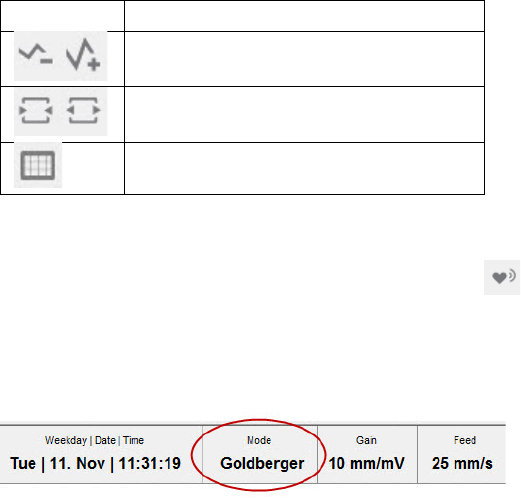
CardioPet Software for Windows PC 17
Adjusting the ECG display
Changing gain, feed, and grid
Select…
To…
Decrease or increase the gain
(recommended: 10 mm/mV)
Decrease or increase the paper feed
(recommended: 50 mm/s)
Display .04 second squares
Listening to the patient’s heartbeat
While the ECG is streaming, click Acoustic Heart Beat .
You must have speakers connected to your computer; make sure the sound is not muted.
Changing the display mode
The currently displayed lead is identified in the Mode area of the toolbar.
Note: The ECG uploaded to vetmedstat.com will always include all six leads.
To change the displayed leads:
From the ECG menu, select:
• Single Lead to display lead II.
• Einthoven to display leads I, II, and III.
• Goldberger to display all six leads.
Changing the recording duration
1. Select Settings > ECG Options….
2. Under Recording Time, select either 30 sec or 1 min from the dropdown menu, and then
click OK.

CardioPet Software for Windows PC 18
Completing the case on vetmedstat.com
Completing a new case
Note: If you clicked Upload to VetMedStat and complete now , the vetmedstat.com web site
opens automatically. Proceed to step 2 below.
To complete the case on vetmedstat.com:
1. Log on to vetmedstat.com, find the case under Attention: Cases for You to Complete, and click the
Finish button.
2. On the Patient page, edit the patient and owner information as needed, and then click Next.
Note: You will not be able to edit patient information after you leave the Patient page.
3. On the Service pages:
a. Choose Cardiology Services, and then select the specific service.
b. Click Next.
c. Choose the desired screen or consult type.
d. Click Next.
IMPORTANT: For cardiology services, send only cardiac-specific images. If you include images for
other areas of study, you must also select an applicable Radiology or Dental service. You can select
multiple services for the same case, but each report will incur a separate charge.
4. Complete required history and click Next.
5. On the Attachments page, ensure all necessary ECG files, images, and documents are listed under
Files Already Attached. To submit files in addition to the ECG you already uploaded, under Additional
attachments, select Upload now, and follow instructions to attach the files.
Tip: If this is a comparison study, attach any relevant documents older than 1 year.
6. Click Next.
7. On the Summary page, review the case information (click Previous to make any needed changes),
and then click Submit Case.
The Home page is displayed, showing the submitted case under Cases Successfully Submitted.
When the case report is ready, look for it under Completed Reports on the Home page. The veterinarian
will also receive the report by email or fax, depending on the veterinarian’s contact settings.
Recording and completing a repeat case
IMPORTANT: Do not include images, such as radiographs, with a repeat ECG.
To submit a repeat ECG:
1. Go to vetmedstat.com.
2. Under Completed Reports, locate the original case, click the case number, and then select Repeat
ECG (or Repeat Screen) from the menu.
Note: This option is available only if the case is eligible for a reduced-charge repeat service.
3. Note the ID listed below the patient’s name, and then click Next.
4. Update the Notes page with current patient history and exam findings, then click Next.
5. Open the CardioPet software.
CardioPet Software for Windows PC 19
6. Click Select and Manage ECG and create a new patient or find the existing patient, ensuring the
patient ID is the ID noted in step 3.
7. Record the repeat ECG.
8. Click Upload to VetMedStat and complete later to add the ECG to the repeat case on
vetmedstat.com.
9. Return to vetmedstat.com, refresh the page, and complete the case.
Note: Before submitting, make sure the ECG file appears on the Attachments page under Files already
attached or on the Summary page by clicking View Images.
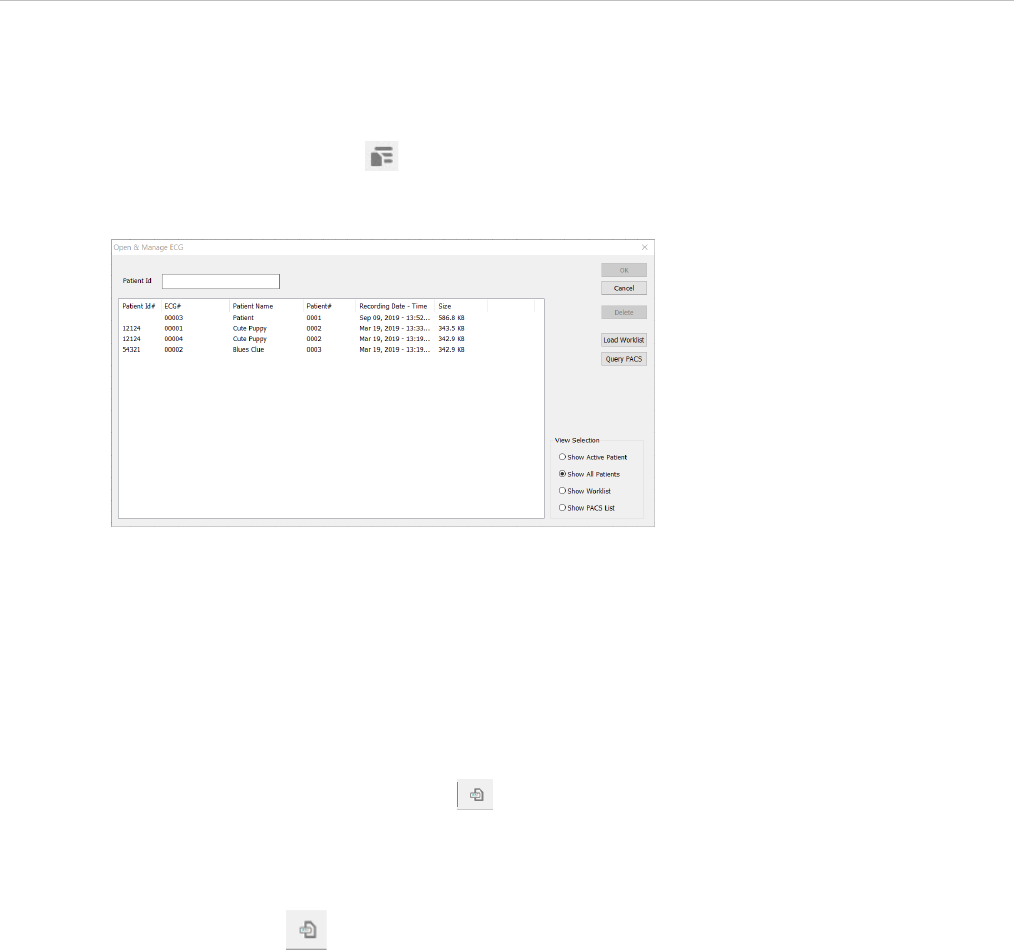
CardioPet Software for Windows PC 20
Working with saved ECGs
Viewing a saved ECG
1. Select the patient.
2. Click Open & Manage ECG .
A list of ECGs for the currently active patient is displayed. To find an ECG for a different patient, select
Show All Patients in the lower right corner of the window.
3. Double-click the ECG row.
Note: To delete an ECG, highlight it by clicking it once, and then click Delete.
Saving an ECG as a PDF file
Before you begin: To use this feature, go to Settings > Dicom Settings and enter your practice name in the
Institution Name field.
1. View the ECG within the CardioPet software and identify the areas of interest.
2. Click in the center of an area of interest to apply a green bookmark. You must apply at least one
bookmark to activate the Save As PDF icon.
Note: The bookmark represents the center of a 40 cm area. If the bookmark is less than 20 cm from the
beginning or end of the ECG, the bookmark will shift to 20 cm from the applicable edge.
3. Repeat step 2 as many times as necessary to capture all areas of interest.
4. Click Save As PDF in the CardioPet toolbar, or select Save As PDF from the File menu, and then
select a location to store the PDF.
Tip: To clear all bookmarks, right-click the ECG. The bookmarks are removed.
The PDF includes:
• Areas of interest bookmarked on the ECG tracing
• Practice name as entered in the settings (Settings > Dicom Settings > Institution Name)
• Patient name and ID
• Date and time of the ECG recording
• Paper speed and amplitude
Note: The paper speed is half the speed noted in the CardioPet software to compensate
for the difference when viewing the tracing on a monitor in landscape mode vs. in the
portrait-oriented PDF.

CardioPet Software for Windows PC 21
Exporting an ECG from the CardioPet software
The CardioPet software supports two exported ECG file types:
• .ecg (the default)
• .dce (a DICOM* format).
Before you begin: To activate the export option, go to Settings > Dicom Settings and enter your practice
name in the Institution Name
field. You need to do this only once.
To export an ECG:
1. Open the ECG file.
2. Click Export ECG . The default export file type is .ecg. To export the ECG as a DICOM file, select
.dce in the Save As Type box.
3. Navigate to the desired location, and then click Save.
Note: To view an exported CardioPet file, you must import the file back into the CardioPet software. See the
next section.
Tip: You can also save an ECG as a .pdf file.
Importing an ECG into the CardioPet software
1. In the CardioPet software, open the patient record associated with the file to be imported.
2. Click Import ECG . If importing a .dce file, select .dce in the pop-up window.
3. Navigate to the file location, select the file, and then click Open.
4. In the Import ECG box, verify the ECG recording date, and then click OK.
The Select Patient dialog box opens with the active patient already selected. Confirm the correct
patient is selected, or create a new patient.
5. Click OK to add the file to the patient record.

CardioPet Software for Windows PC 22
Managing patient records
To create new patient records:
1. Click Select & Manage Patient .
2. Click New, and then enter patient and owner information.
3. To associate ECG files for this patient with records in the IDEXX-PACS software or a practice
management system, enter the patient ID from the other system in the CardioPet Patient ID box.
4. Click Save.
Note: A reference number is appended to the patient name for tracking purposes. This number does
not need to match the patient ID in other systems.
5. When finished, click OK.
To update patient records:
1. Click Select & Manage Patient .
2. Select the patient from the Patient drop-down list, and then update the Patient ID and owner
information as needed (the patient name cannot be altered), or click Delete.
Note: Before deleting a patient record, you must delete all associated ECGs. See “Viewing a Saved
ECG” for more information.
3. Click Save.
Note: The most recently modified patient becomes the active patient record on the CardioPet window.
CardioPet App for Android Mobile Device 23
CardioPet App for
Android Mobile Device
User guide
CardioPet App for Android Mobile Device 24
Contents
Minimum requirements ................................................................................................................................. 25
Installing the CardioPet app and establishing a Bluetooth connection ........................................................ 26
Preparing the tablet .......................................................................................................................... 26
Installing the app .............................................................................................................................. 26
Pairing the CardioPet ECG Device and configuring settings ........................................................... 26
ECG viewer settings ...................................................................................................................................... 28
Working with ECGs in the CardioPet app ..................................................................................................... 29
Streaming and recording an ECG .................................................................................................... 29
Selecting the patient and saving the ECG ........................................................................................ 30
Submitting an ECG to VetMedStat ................................................................................................... 30

CardioPet App for Android Mobile Device 25
Minimum requirements
IMPORTANT: This section applies only to systems that are not integrated with the IDEXX-PACS* Imaging
Software or IDEXX Web PACS* software. Contact IDEXX Telemedicine Consultants at 1-800-726-1212 for
additional information about integration.
• The tablet’s Android* operating system must be version 7.1 or later.
• IMPORTANT: Although the CardioPet* App for Android* Mobile Device should be compatible with
Android-based tablets, we cannot guarantee compatibility with every Android device. Contact
IDEXX Telemedicine Consultants to validate compatibility.
• If this is a new Android device, follow the instructions that came with the device to complete its initial
setup before proceeding.
• An internet connection is needed for installing the app, uploading an ECG file from the CardioPet* app
to vetmedstat.com, and submitting a case directly on vetmedstat.com.
• A Google* account is needed to download apps from the Google Play* store.
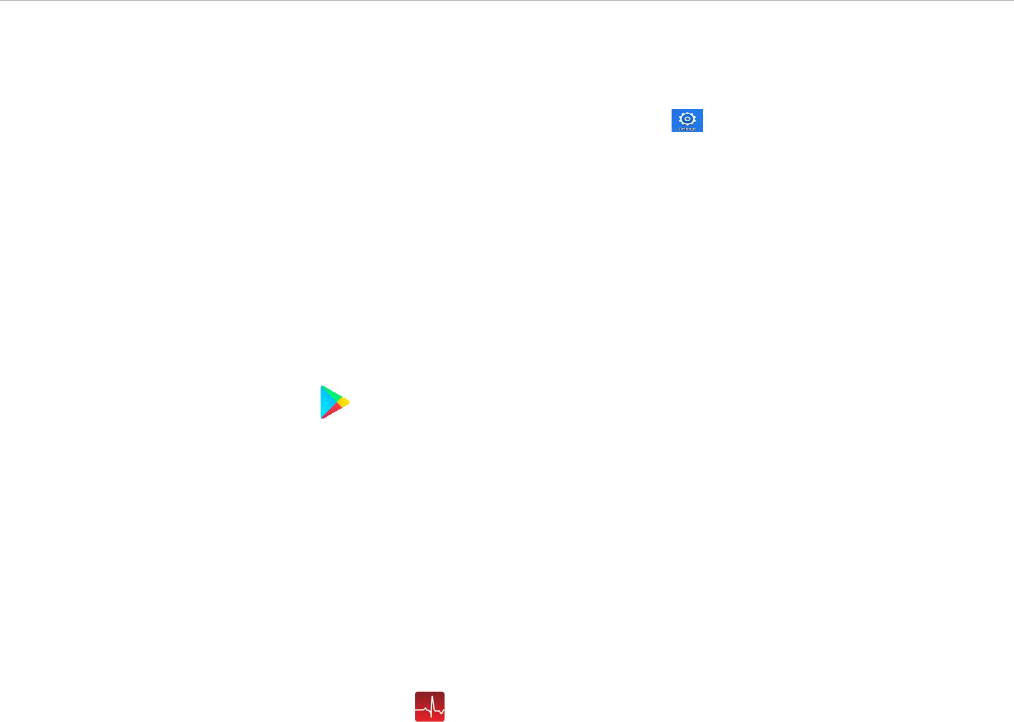
CardioPet App for Android Mobile Device 26
Installing the CardioPet app and establishing a Bluetooth
connection
Preparing the tablet
1. On the tablet, go to the device settings (usually accessed by tapping ).
2. Verify that Wi-Fi is enabled and connected.
3. Update the screen timeout to 30 minutes (or your preferred time, but more than 1 minute).
4. Confirm that the date, time, and time zone are set accurately for your location.
5. Verify that the Bluetooth* connection is turned on.
6. If prompted to enter the Bluetooth Pairing Request PIN, enter 3001.
Installing the app
1. Install the CardioPet app:
a. Tap the Google Play icon.
b. Search for IDEXX CardioPet, and then choose Install.
c. Agree to the Terms of Service and Privacy Policy.
d. Open the CardioPet app when the installation is complete.
Pairing the CardioPet ECG Device and configuring settings
IMPORTANT: Only one instance of the software or app can be used at a time; close all other open
CardioPet applications including the CardioPet software on a Windows* PC.
To pair the CardioPet ECG Device with the CardioPet app:
1. Turn on the Android tablet and tap to start the CardioPet App.
2. Turn on the CardioPet ECG Device.
3. Tap Settings at the top left side of the CardioPet app.
4. Tap in each of the following fields and then update the information as needed:
Telemedicine
a. VMS User Name and VMS Password: Enter your practice’s VetMedStat* account information. The
account name is three letters followed by four numbers. The password is case sensitive.
b. VMS URL: api.vetmedstat.com (leave as is; do not change)
Note: Red check marks turn green when the Android device is connected to the internet and the
VMS user name and password are entered correctly. For assistance, email
teledmedicinesupport@idexx.com or call 1-800-726-1212.

CardioPet App for Android Mobile Device 27
Bluetooth
a. If no device is listed in the Bluetooth section, tap Refresh.
b. Select the device name that starts with the letters CP and matches the serial number on the back of
the device. Refreshing may take a few minutes the first time.
c. Provide permission for Bluetooth to pair with the tablet, if prompted
General
a. Recording Time: Select the recording duration you prefer (30 or 60 seconds).
b. Weight Unit: Select the weight units you prefer (Kg or Lb).
c. Quality Indicator Species Selection: Select Always Ask Species unless all ECGs will be performed
on just one of the listed species. This feature will prompt a request for species prior to each ECG,
which allows CardioPet the best ECG recording possible.
5. Tap Close at the top left side to exit Settings.
Note: In Settings, you can go to About to find the CardioPet version, Terms of Use, and Privacy Policy.
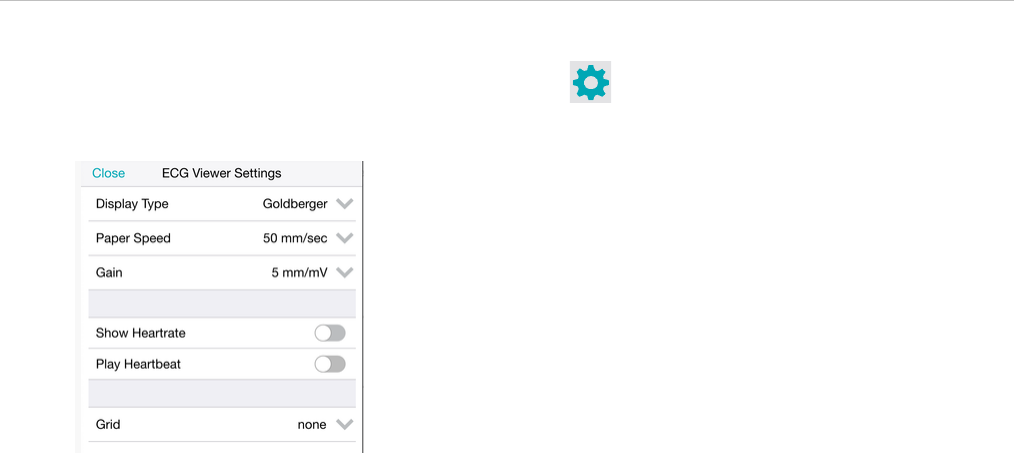
CardioPet App for Android Mobile Device 28
ECG viewer settings
1. To access the ECG Viewer Settings screen, tap Settings at the bottom left side of the CardioPet app.
These settings relate specifically to how the ECG is viewed on the Android’s screen and do not impact the
saved ECG file.
2. Set the following items to your viewing preferences:
• Display Type: Single Lead, Einthoven (3 leads), or Goldberger (6 leads)
• Paper Speed: Scroll to see all speed options and select the desired setting (50mm/sec is
recommended).
• Gain: 2.5 mm/mV, 5 mm/mV, 10 mm/mV (recommended)
•
Show Heartrate: When this feature is turned on, the CardioPet app shows a calculation of the patient's
heart rate in the top left corner of the app.
• Play Heartbeat: When this feature is turned on, the CardioPet app makes an audible beep to the
rhythm of the heart rate.
• Grid: Choose between fine, medium, course, or no gridlines behind the ECG tracing in the app.
3. Tap Close at the top left side of the screen.

CardioPet App for Android Mobile Device 29
Working with ECGs in the CardioPet app
Streaming and recording an ECG
1. Open the CardioPet app on the Android tablet.
2. Turn on the CardioPet* device.
When the wireless communication light turns on, the ECG starts streaming automatically in the CardioPet
app. (The Android tablet’s Bluetooth* setting must be On.)
Note: The first time an Android tablet is used with the CardioPet device, the device may need to be paired
through the CardioPet app settings.
3. If prompted, select the patient’s species.
4. Prepare the patient. See Preparing the Patient for additional details.
When the ECG tracing is diagnostic, tap Start Recording at the bottom right of the screen. See
“Diagnostic ECG checklist” for more information.
TIP: On CardioPet device models 02 and newer, you can also lightly depress the power button on the
CardioPet device to start recording.
The live stream and recording stop automatically once the app records the ECG for 30 or 60 seconds
(depending on your setting).
5. To turn off the CardioPet device, press and hold the power button for about 5 seconds; the device will also
turn off automatically after 5 minutes of inactivity.
Note: The ECG must be at least 20 seconds long. If the Recording icon is tapped while recording is in
progress, you may receive a Short ECG warning:
TIP: To discard a recorded ECG, tap Delete in the top right corner of the screen.
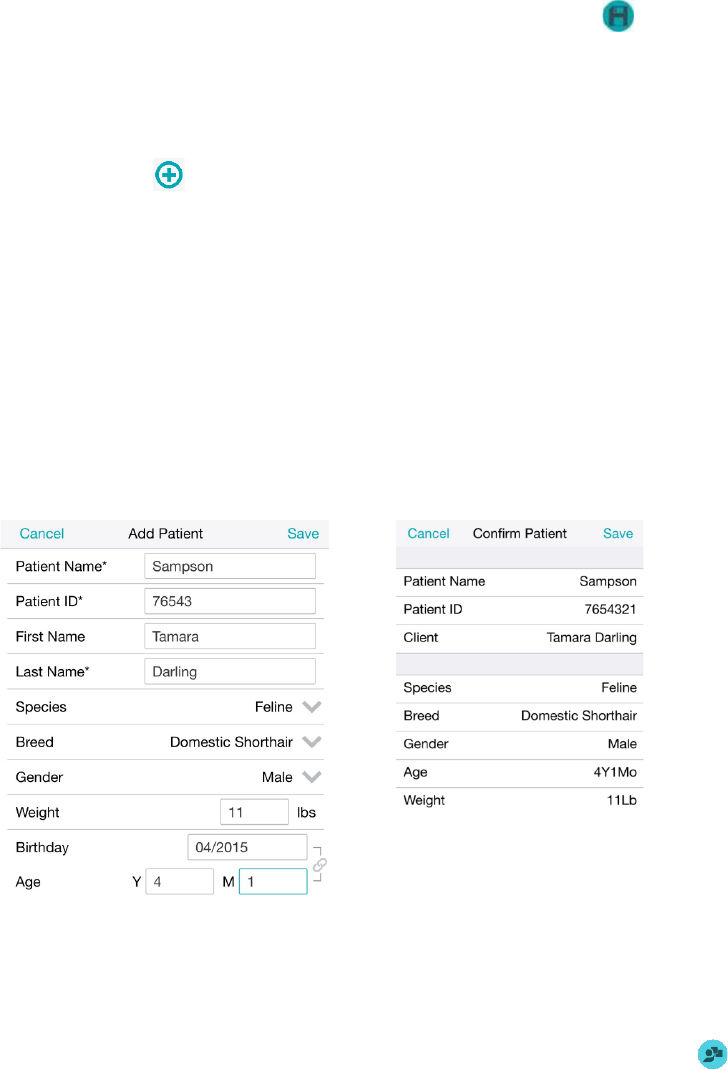
CardioPet App for Android Mobile Device 30
Selecting the patient and saving the ECG
1. At the bottom right side of the CardioPet app, tap Select Patient & Save . The Local Patients window
opens.
2. Assign the ECG to an existing patient or to a new patient as follows:
• Existing patient: Tap the patient name in the Local Patients list, and tap Save in the Confirm Patient
window.
• New patient: Tap at the top right of the Local Patients window and complete all fields.
TIP: Entering the date of birth in the Birthday field calculates the patient age and vice versa.
3. (Optional) To record an additional ECG, tap Live ECG in the upper left corner of the screen.
Notes:
• Patient ID must be unique.
• Using the patient ID from your practice management system is recommended. Be sure to check with
your practice management system provider to determine whether a patient ID is in use. Settings may
need to be configured to display hidden IDs.
• If your practice management system does not provide a patient ID, you can add a letter, a number, or
the patient’s name to the client ID to create a unique patient ID.
Add Patient window
Confirm Patient window
Submitting an ECG to VetMedStat
1. To locate a previously recorded ECG, tap ECGs at the top right of the CardioPet app main screen.
2. Tap the desired ECG in the Recent ECGs list, and then tap Close.
3. When the desired ECG is visible on the screen, tap Start a Telemedicine Case at the bottom right
side of the app.
4. In the Upload window, select one of the following:
• Finish Now: To open vetmedstat.com, where you can complete the case immediately. See
“Completing the case on vetmedstat.com”
• Finish Later: To upload the ECG without opening vetmedstat.com. You must log on to
vetmedstat.com later to complete the case. Use this option if there is a case already started with
other image files. See Submitting cases with multiple modalities on vetmedstat.com/cardiopet.
• Cancel: Closes the window.
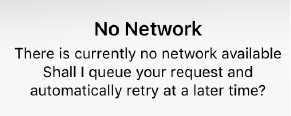
CardioPet App for Android Mobile Device 31
TIP: If there is no internet connection available when you tap an Upload option, a No Network error message
opens. Tap
OK to queue the request for automatic retry at a later time.
CardioPet iOS App 32
CardioPet iOS App
User Guide
CardioPet iOS App 33
Contents
Minimum requirements ................................................................................................................................. 34
Checking compatibility.................................................................................................................................. 35
Configuring general iPad settings ................................................................................................................ 36
Installing the CardioPet app and configuring app settings .......................................................................... 38
Configuring ECG viewer settings .................................................................................................................. 39
Working with ECGs in the CardioPet app ..................................................................................................... 40
Streaming and recording an ECG .................................................................................................... 40
Selecting the patient and saving the ECG ........................................................................................ 41
Submitting an ECG to VetMedStat ................................................................................................... 41

CardioPet iOS App 34
Minimum requirements
IMPORTANT: This section applies only to systems that are not integrated with the IDEXX-PACS* Imaging
Software or IDEXX Web PACS* software. Contact IDEXX Telemedicine Consultants at 1-800-726-1212 for
additional information about integration.
• The CardioPet* ECG Device must be model 04 or later.
• An internet connection is needed for installing the app, uploading an ECG file from the CardioPet* iOS
App to vetmedstat.com, and submitting a case directly on vetmedstat.com from the iOS* device.
• To download the CardioPet app from the App Store*, an Apple* ID is required.
• Your Apple* iPad* must have iOS* 11 or later.
• IMPORTANT: Although the CardioPet app should be compatible with iPad devices, we cannot
guarantee compatibility with every iOS device. Contact IDEXX Telemedicine Consultants to validate
compatibility.
Use the following resources to help identify your iPad model: Apple* support or the Apple* check-coverage
page (checkcoverage.apple.com/)
Note: The CardioPet software cannot be used with an iPhone*.
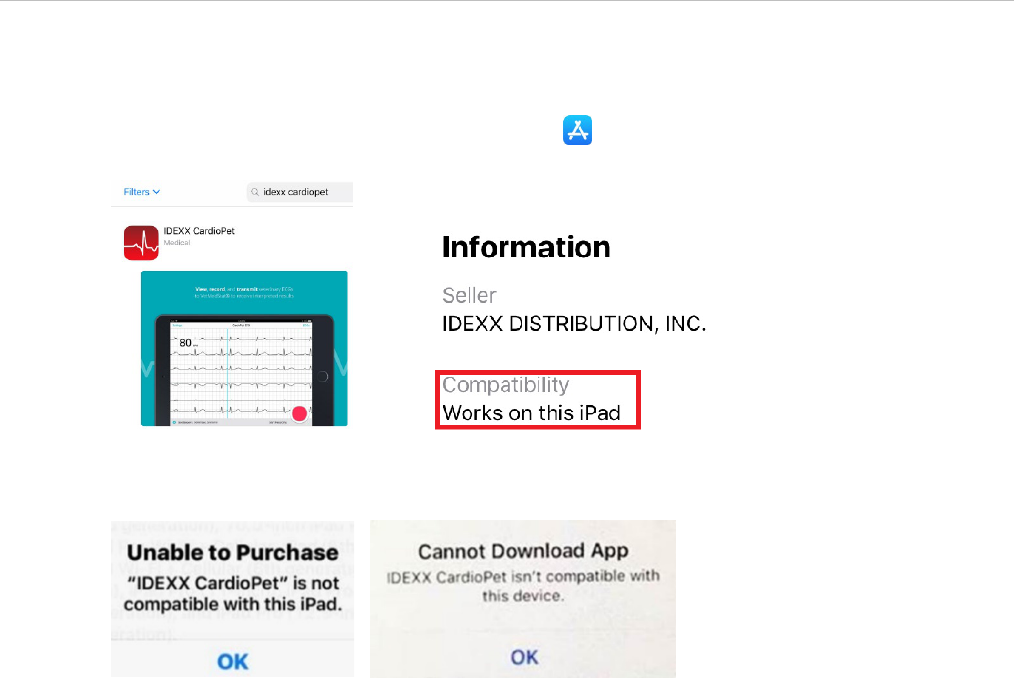
CardioPet iOS App 35
Checking compatibility
There are two ways to check whether the CardioPet app will work on your iPad:
• Refer to the CardioPet app Information box. It should say “Works on this iPad.”
To view the Information box: Open the App Store on the iPad and search for IDEXX CardioPet.
Tap on the app and scroll to Information to view compatibility.
• Try to download the CardioPet app from the App Store. If the iPad and iOS versions are not compatible
with the app, the app will not download successfully, and you may see error messages like these:
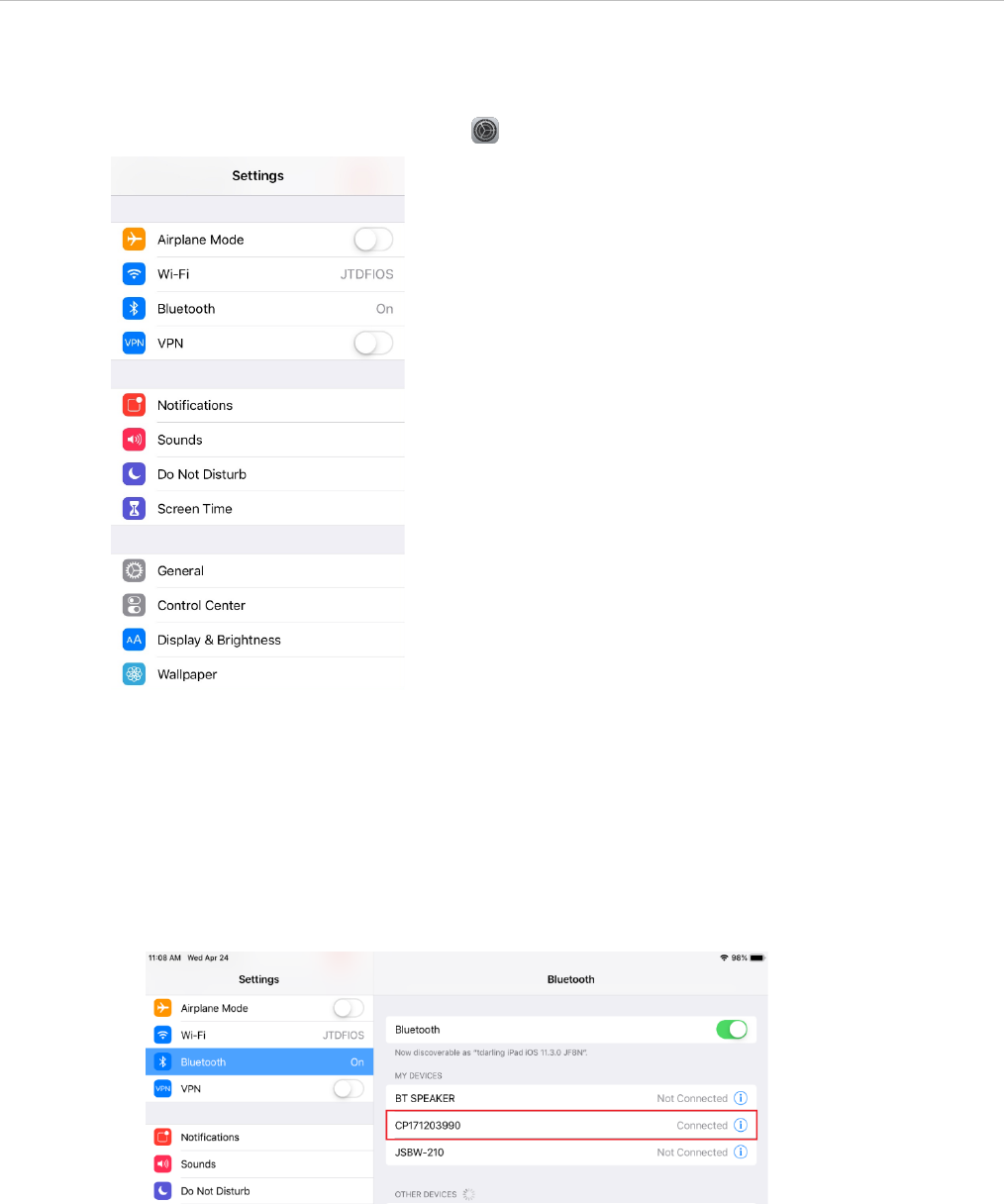
CardioPet iOS App 36
Configuring general iPad settings
IMPORTANT: If the iPad is new, first follow the instructions that came with the device to complete its initial
setup, and then proceed with the steps below.
1. To access the iPad settings, tap Settings on the tablet screen.
2. In the Wi-Fi setting, verify that Wi-Fi is enabled and connected to a strong internet signal.
An internet connection is needed for installing the CardioPet app, uploading an ECG file from the
CardioPet app to vetmedstat.com, and submitting a case to vetmedstat.com directly from the iOS*
device.
3. Connect Bluetooth* to the CardioPet ECG device as follows:
a. Turn on the CardioPet* ECG Device.
b. In the iPad Settings, tap Bluetooth and ensure it is set to On.
c. Select the device name that starts with the letters CP.
d. Once the CP device appears under My Devices, turn off the CardioPet device by holding down the
power button for about 5 seconds.

CardioPet iOS App 37
Important: If the CardioPet device will be paired with multiple devices, then Bluetooth should be
disabled (turned off) on any iPad not currently being used with the CardioPet device. The CardioPet
device can be used with only one Bluetooth-enabled device at a time.
4. Specify general settings
a. Software Update: Check to see whether a software update is available; if it is, install it now.
Updates often include important defect corrections and enhancements. Not having the most current
iOS version may affect your CardioPet user experience.
b. Date & Time: Confirm that the date, time, and time zone are set accurately for your location.
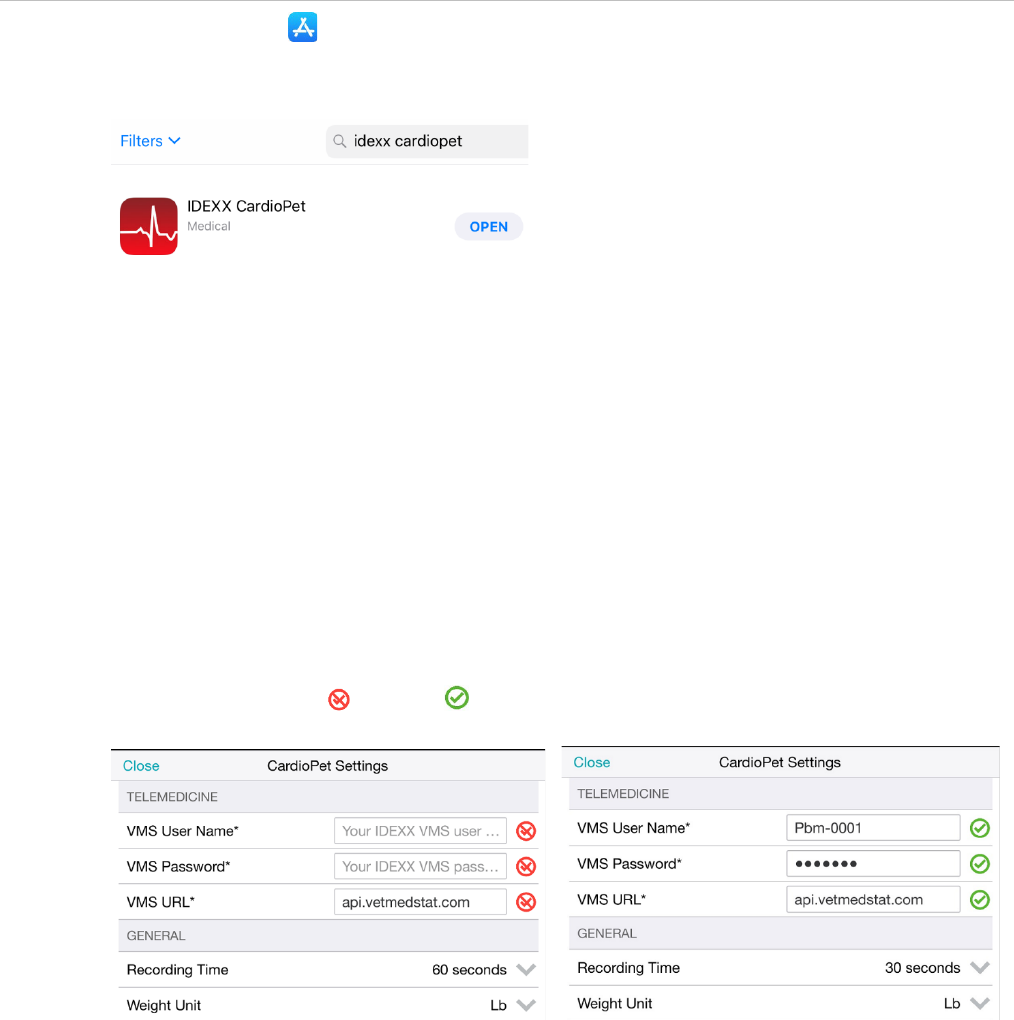
CardioPet iOS App 38
Installing the CardioPet app and configuring app settings
1. Open the App Store on the iPad, and search for IDEXX CardioPet.
2. Select the CardioPet app in the search results, and then tap GET.
3. When the installation is complete, tap OPEN.
4. Tap Accept to accept the Terms of Service and Privacy Policy.
5. Tap Settings at the top left side of the IDEXX CardioPet app.
6. Tap in each of the following fields, and then update the information as needed:
• Telemedicine
− VMS User Name and VMS Password: Enter your practice’s VetMedStat* account information.
The account name is three letters followed by four numbers. The password is case sensitive.
− VMS URL: api.vetmedstat.com (leave as is; do not change)
• General Recording
− Time: Select the recording duration you prefer (30 or 60 seconds).
− Weight Unit: Select the weight units you prefer (Kg or Lb).
• Quality Indicator Species Selection: Select Always Ask Species unless all ECGs will be performed
on just one of the listed species. This feature will prompt a request for species prior to each ECG,
which allows CardioPet the best ECG recording possible.
Note: Red checkmarks turn green if the iPad is connected to the internet and the VMS user
name and password are entered correctly.
7. Tap Close at the top left side to exit Settings.
Note: In Settings, you can go to About to find the CardioPet version, Terms of Use, and Privacy Policy.

CardioPet iOS App 39
Configuring ECG viewer settings
1. To access the ECG Viewer Settings screen, tap Settings at the bottom left side of the CardioPet app.
These settings relate specifically to how the ECG is viewed on the iPad screen and do not impact the saved
ECG file.
2. Set the following items to your viewing preferences:
• Display Type: Single Lead, Einthoven (3 leads), or Goldberger (6 leads)
• Paper Speed: Scroll to see all speed options and select the desired setting (50mm/sec is
recommended).
• Gain: 2.5 mm/mV, 5 mm/mV, 10 mm/mV (recommended)
• Heartrate: When this feature is turned on, the CardioPet app shows a calculation of the patient's heart
rate in the top left corner of the app.
• Heartbeat: When this feature is turned on, the CardioPet app makes an audible beep to the rhythm of
the heart rate.
• Alerts: When this feature is turned on, the CardioPet app will provide alerts.
• Grid: Choose between fine, medium, course, or no gridlines behind the ECG tracing in the app.
3. Tap Close at the top left side of the screen.

CardioPet iOS App 40
Working with ECGs in the CardioPet app
Streaming and recording an ECG
1. Open the CardioPet app on the iPad*.
2. Turn on the CardioPet* device.
When the wireless communication light turns on, the ECG starts streaming automatically in the CardioPet
app. (The iPad Bluetooth* setting must be On.)
Note: The first time an iPad is used with the CardioPet device, the device must be paired to Bluetooth on the
iPad.
3. If prompted, select the patient’s species.
4. Prepare the patient. See “Preparing the Patient” for additional details.
5. When the ECG tracing is diagnostic, tap Start Recording at the bottom right of the screen. See
“Diagnostic ECG checklist” for more information.
TIP: You can also lightly depress the power button on the CardioPet device to start recording.
The live stream and recording stop automatically once the app records the ECG for 30 or 60 seconds
(depending on your setting).
6. To turn off the CardioPet device, press and hold the power button for about 5 seconds; the device will also
turn off automatically after 5 minutes of inactivity.
Note: The ECG must be at least 20 seconds long. If the Recording icon is tapped while recording is in
progress, you may receive a Short ECG warning:
TIP: To discard a recorded ECG, tap Delete in the top right corner of the screen.

CardioPet iOS App 41
Selecting the patient and saving the ECG
1. At the bottom right side of the CardioPet app, tap Select Patient & Save . The Local Patients
window opens.
2. Assign the ECG to an existing patient or to a new patient as follows:
• Existing patient: Tap the patient name in the Local Patients list, and tap Save in the Confirm Patient
window.
• New patient: Tap at the top right of the Local Patients window and complete all fields.
TIP: Entering the date of birth in the Birthday field calculates the patient age and vice versa.
3. (Optional) To record an additional ECG, tap Live ECG in the upper left corner of the screen.
Notes:
• Patient ID must be unique.
• Using the patient ID from your practice management system is recommended. Be sure to check with
your practice management system provider to determine whether a patient ID is in use. Settings may
need to be configured to display hidden IDs.
• If your practice management system does not provide a patient ID, you can add a letter, a number, or
the patient’s name to the client ID to create a unique patient ID.
Add Patient window
Confirm Patient window
Submitting an ECG to VetMedStat
1. To locate a previously recorded ECG, tap ECGs at the top right of the CardioPet app main screen. Tap
the desired ECG in the Recent ECGs list, and then tap Close.
2. When the desired ECG is visible on the screen, tap Start a Telemedicine Case at the bottom right
side of the app.
3. In the Upload window, select one of the following:
• Finish Now: To open vetmedstat.com, where you can complete the case immediately. See
“Completing the case on vetmedstat.com”
• Finish Later: To upload the ECG without opening vetmedstat.com. You must log on to
vetmedstat.com later to complete the case. Use this option if there is a case already started with
other image files. See Submitting cases with multiple modalities on vetmedstat.com/cardiopet.
• Cancel: Closes the window.

CardioPet iOS App 42
TIP: If there is no internet connection available when you tap an Upload option, a No Network error
message opens. Tap
OK to queue the request for automatic retry at a later time.
Integrating the CardioPet App with IDEXX-PACS or IDEXX Web PACS 43
Integrating the CardioPet App
with IDEXX Web PACS or
IDEXX-PACS
User Guide

Integrating the CardioPet App with IDEXX-PACS or IDEXX Web PACS 44
Integrating the CardioPet app with IDEXX Web PACS or
IDEXX-PACS Imaging Software
Integrating a CardioPet app with IDEXX Web PACS* or the IDEXX-PACS* Imaging Software lets you keep
ECGs, radiographs, and other digital images together in the same patient record in IDEXX-PACS. You can
then submit the images to IDEXX Telemedicine Consultants (vetmedstat*) as a single case.
Integration requirements:
• A CardioPet app installed on an eligible Windows* PC, Android* mobile device, or iPad* tablet
• IDEXX-PACS software version 4.2.1 or later, and/or an IDEXX Web PACS subscription.
Contact IDEXX Telemedicine Consultants at 1-800-726-1212 for additional information and/or to schedule a
remote session with a representative who will help you set up the integration.
Sending ECGs to IDEXX Web PACS or IDEXX-PACS software
For instructions on sending ECGs, please refer to the document provided to you during integration setup.
Submitting a case from within the IDEXX Web PACS or
IDEXX-PACS software
Refer to your IDEXX Web PACS or IDEXX-PACS online help for instructions on submitting cases to
IDEXX Telemedicine Consultants (vetmedstat.com) from within the IDEXX-PACS software. You can include
radiographs, ultrasounds, and ECGs in a single submission.
IMPORTANT: For cardiology services, send only cardiac-specific images. If you include images for other
areas of study, you must also select an applicable Radiology or Dental service. You can select multiple
services for the same case, but each report will incur a separate charge.
ECG Quality and Troubleshooting 45
ECG Quality and
Troubleshooting
User Guide
ECG Quality and Troubleshooting 46
Contents
Examples of diagnostic ECGs ...................................................................................................................... 47
ECG quality Indicator .................................................................................................................................... 48
Diagnostic ECG checklist ............................................................................................................................. 50
Troubleshooting ECGs ................................................................................................................................. 51
Indistinct P-waves and movement artifact ........................................................................................ 51
Flat lines or indistinct complexes ...................................................................................................... 51
Blurry lines ........................................................................................................................................ 52
Small or absent P-waves .................................................................................................................. 52
Inverted P-waves .............................................................................................................................. 52
Vertical red bar in the ECG tracing ................................................................................................... 52
Crowded or overlapping complexes ................................................................................................ 52
ECG tracing is not visible in the software ......................................................................................... 52
Additional troubleshooting tips ..................................................................................................................... 53
Case is not visible in vetmedstat.com .............................................................................................. 53

ECG Quality and Troubleshooting 47
Examples of diagnostic ECGs
Diagnostic canine ECG
Diagnostic feline ECG

ECG Quality and Troubleshooting 48
ECG Quality Indicator tool
The newest versions of the CardioPet* software/app include an ECG Quality Indicator tool, which provides
real-time feedback on ECG quality and lead placement. The Quality Indicator will change the color of any
potentially affected leads to yellow and will provide additional troubleshooting information.
If you have completed all troubleshooting and continue to receive the Quality Indicator error, you may close
the alert and continue recording.
For more troubleshooting information, review the following:

ECG Quality and Troubleshooting 49
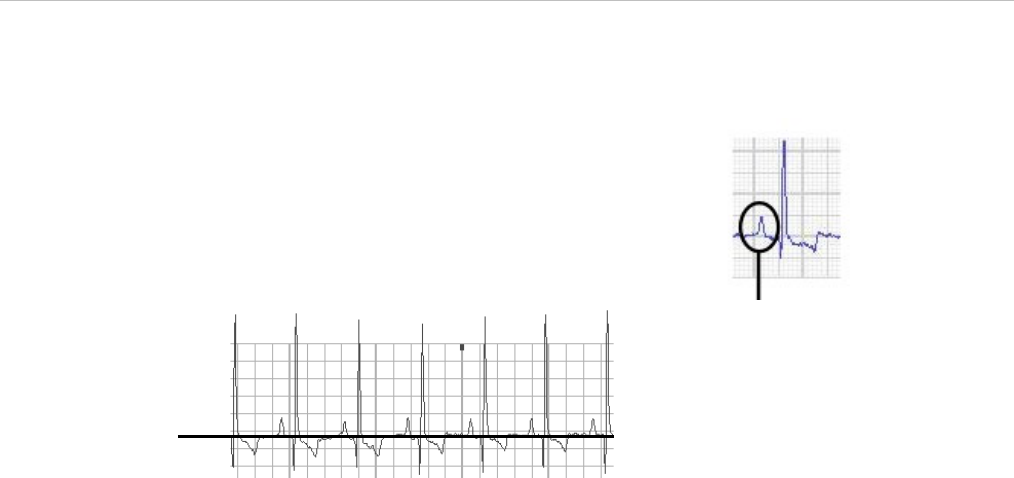
ECG Quality and Troubleshooting 50
Diagnostic ECG checklist
It is important that tracings submitted to our cardiology team are diagnostic. This means that:
• The P-waves are visible and distinct from motion artifact in lead II. The P-wave may be very small or
invisible on leads I and III, especially in feline ECGs.
• The P-wave (if visible):
− is positive (points upward) in leads I, II, and III.
− is negative (points downward) in lead AVR.
− may be either positive or negative in leads AVL and AVF.
• The ECG baseline is generally level.
Baseline
P-wave

ECG Quality and Troubleshooting 51
Troubleshooting ECGs
Indistinct P-waves and movement artifact
P-waves may be “washed out” by artifacts caused by panting, shaking, and vocalizing.
Feline ECG with indistinct P-waves caused by purring
Canine ECG with respiratory (panting) artifact
To reduce movement artifact:
• Move clips below the knees and elbows.
• Distract the patient by tapping gently on the nose or offering them a treat out of a closed hand.
• Apply gentle pressure to the chest and/or legs.
• Reposition the patient (if patient is standing, place in right-lateral position, or the reverse).
• Record a chest lead to distinguish P-waves from movement artifacts.
Flat lines or indistinct complexes
Make sure clips have sufficient skin contact and alcohol saturation for conduction.
Flat lines and indistinct complexes

ECG Quality and Troubleshooting 52
Blurry lines
Make sure clips are secure and have sufficient alcohol saturation for conduction.
Blurry lines
Small or absent P-waves
Record a chest lead if P-waves are small, inconsistent, or absent. See “Positioning clips for a chest lead,” for
more information.
Inverted P-waves
If the P-wave is not positive in leads I, II, and III, or negative in lead AVR, ensure the leads are correctly
plugged into the CardioPet* ECG Device and the clips are attached to the correct legs. See “Connecting the
batteries and cables” and “Preparing the patient” for more information.
Vertical red bar in the ECG tracing
A vertical red bar in the ECG tracing indicates a data integrity error. For example, the patient may be out of
the device’s transmission range. Try moving the device closer. Remove any obstacles between the device
and the software.
Crowded or overlapping complexes
Gain may be too high or feed too slow. Try a gain of 10 mm/mV and a feed of 50 mm/s. See “Adjusting the
ECG stream” in the section for the computer or tablet you are using.
ECG tracing is not visible in the software
Windows PC:
• Check that the wireless communication light is illuminated on the CardioPet ECG Device. If it is not, try
restarting the device.
• In Bluetooth* settings, remove the CardioPet ECG Device and then add it again. The pairing code is
3001.
• Make sure the correct serial number is in the CardioPet software (Settings > ECG Options).
• Restart the computer.
• If necessary, uninstall and reinstall the CardioPet software.
Android or IOS device:
• Try enabling the connection to the CardioPet ECG device again. Refer to the instructions in the section
for your tablet type.

ECG Quality and Troubleshooting 53
Additional troubleshooting tips
Case is not visible in vetmedstat.com
If the case was uploaded from a Windows* PC:
• In the CardioPet software, select Settings > ECG Options. Under VetMedStat Account, verify that
the VetMedStat* user name and password are correct.
• Verify that your PC has an Internet connection.
If the case was uploaded from an Android* or iOS* device:
• Hold down the *Menu button, and then tap Settings . Verify that the VetMedStat account number
and password are correct and that the domain is api.vetmedstat.com.
• Verify that the device is connected to a Wi-Fi network with internet access.

If you need help…
If you need help installing or using the CardioPet software, CardioPet app, or the CardioPet ECG Device:
• Contact IDEXX Telemedicine Consultants at 1-800-726-1212.
• Visit vetmedstat.com/cardiopet.
• Email telemedicinesup[email protected].
IDEXX Laboratories, Inc.
One IDEXX Drive, Westbrook, Maine 04092 USA
1-207-556-0300 or 1-800-548-6733

